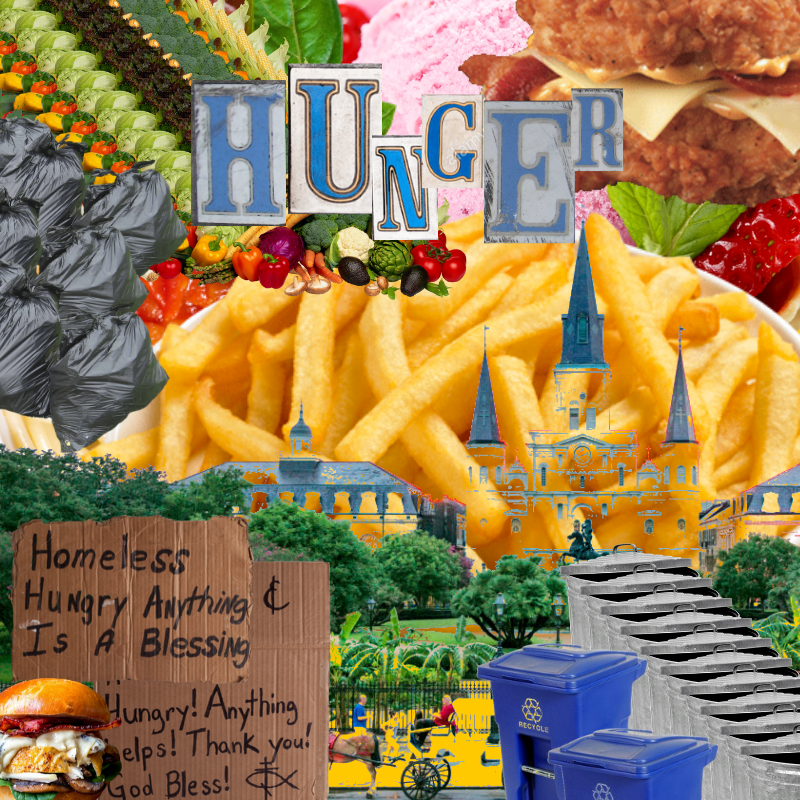
A digital collage depicting the hunger crisis and food waste cycle in New Orleans .(Cred: Emily Baldridge)
Despite being known globally for its delicious cuisine, the New Orleans area and the state of Louisiana are struggling with food insecurity. The United States Department of Agriculture (USDA) defines food insecurity as “a lack of consistent access to food for every person in the household to live an active, healthy life”(USDA). Within New Orleans and Louisiana, this issue is growing worse and worse. Currently, Louisiana has the second highest rate of food insecurity in the United States. Furthermore, this rate is rising at a higher pace than the rest of the country. While governmental forces are in place to try and combat this issue, the services provided are not effectively addressing food insecurity and access. This is why community-driven initiatives are vital.
Enter Second Harvest Food Bank, founded in 1982. Second Harvest Food Bank’s mission is to help its communities navigate issues of hunger and educate them on available resources. Second Harvest Food Bank follows a two-fold objective plan to effectively carry out its stated mission. The first objective is the distribution of food to needy people. While simple in concept this action is something communities need nationally and globally to help combat extensive food insecurity.
The second objective is the elimination of food waste in the food industry. This aspect of Second Harvest Food Banks’ mission is one that is often overlooked when discussing topics of food distribution and hunger. In the United States each year 108 billion pounds of food is wasted. That number translates to 40% of American food being wasted. Learning more about the food distribution process and food waste within the U.S. is vital to combating these issues. Not only is this waste important when discussing hunger within our country, but also when thinking about the global climate crisis. Throwing away waste sustainably and productively for the environment can help make a difference.

Getting involved with programs like Second Harvest Food Bank and others that address food insecurity within our communities is important. Second Harvest Food Bank makes it easy for people to get involved. Interested volunteers begin by creating an account online at https://shfblv.org. Following registration, volunteers can look through the scheduling, where Second Harvest Food Bank lays out events for the current week and beyond at a variety of different times and locations. The range of options allows volunteers to effectively choose different events based on schedule and convenience while addressing the needs of the community. This, however, is not where Second Harvest Food Bank stops its outreach work. In addition to its volunteer program, Second Harvest has a range of informational programs to assist different age ranges with nutrition, waste, and food insecurity issues. For people looking for where to utilize these sources, the website has a map. The map feature allows interested people to navigate to the closest food bank within the desired area.
For any additional information go to https://shfblv.org to learn more about Second Harvest Food Bank. There are numerous people doing important work in the community and it is really easy to get involved and help them out.
This piece was edited by Evan Price as part of Professor Kelley Crawford’s Digital Civic Engagement course at Tulane University.
 NOLAbeings Multimedia artist Claire Bangser created NOLAbeings as a portrait-based story project that marries...
NOLAbeings Multimedia artist Claire Bangser created NOLAbeings as a portrait-based story project that marries...  Voodoo in New Orleans: Reviving history: New Orleans fortune telling This article takes a deep dive into the history of Voodoo in New Orleans, its hybridization with Catholicism, and its present-day place in the city's culture. The author visits fortune-tellers in the French Quarter, using their guidance as a tool for introspection rather than a deterministic predictor of the future. Through her experiences in New Orleans, the author feels a mystical connection to both the past and the future.
Voodoo in New Orleans: Reviving history: New Orleans fortune telling This article takes a deep dive into the history of Voodoo in New Orleans, its hybridization with Catholicism, and its present-day place in the city's culture. The author visits fortune-tellers in the French Quarter, using their guidance as a tool for introspection rather than a deterministic predictor of the future. Through her experiences in New Orleans, the author feels a mystical connection to both the past and the future. 